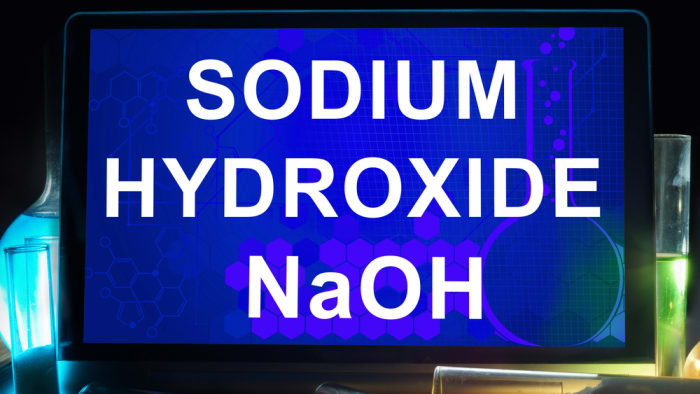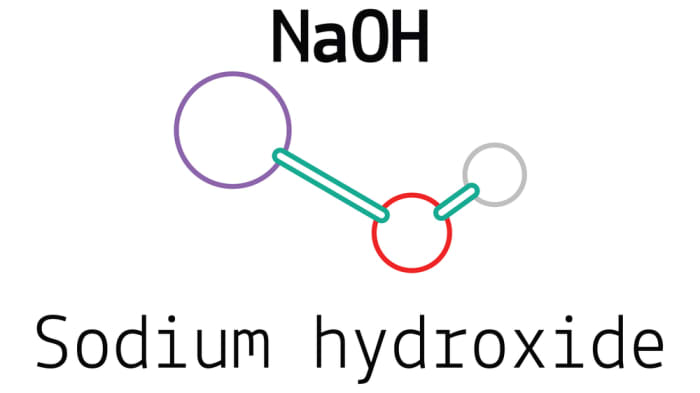Sodium hydroxide and reactions with it
Chemical properties of caustic soda

General characteristics
Sodium hydroxide is a substance that is classified as an alkali. Other names for sodium hydroxide are caustic soda, caustic, lye and caustic alkali. It is a hard white substance, which can absorb water vapor and carbon dioxide from the air. For example, if you leave sodium hydroxide in an open jar, the substance swiftly absorbs water vapor from the air, and after a while will turn into a formless mass. So it is sold in hermetic vacuum containers.
It is also advisable not to store crystals in glass containers, as sodium hydroxide can enter into a reaction with glass and corrode it. When sodium hydroxide is dissolved in water, a large amount of warmth is released, and the solution heats up.
Sodium hydroxide is a dangerous and caustic substance, which can cause severe burns to the skin. So when working with caustic soda, one must observe safety regulations.
At present, NaOH is a popular substance in industrial production, for example around 57 million tons of it are produced and used worldwide each year.
Physical properties

It is a hard white substance, hydroscopic, and dissolves well in water. It has a melting and boiling temperature of 323 and 1403 degrees Celsius respectively.
Obtaining NaOH
Sodium hydroxide is obtained by electrochemical methods. One of these methods is the electrolysis of a solution of halite, a natural mineral which mainly consists of sodium chloride (table salt). Hydrogen and chlorine also form when this method is used.
2NaCl + 2H₂O → H₂ + Cl₂ + 2NaOH

Application of sodium hydroxide
Although the substance is caustic and dangerous, it has found an application in many spheres of industry and other fields as well, and on a very large scale:
- in the pulp and paper industry;
- in soap manufacture;
- in chemical branches of industry;
- in the manufacture of bio diesel fuel;
- in the household for cleaning pipes;
- in cosmetics;
- and many other spheres.
The chemical properties of sodium hydroxide

Sodium hydroxide dissolved in water has a strong alkaline medium. Alkalis in solutions are determined by special indicators, for example litmus paper will turn bright blue. Here you’ll find an impressive experiment with sodium hydroxide.
In the interaction of sodium hydroxide with acids, a neutralization reaction takes place. For example, in the reaction with hydrochloric acid, sodium chloride (table salt) and water form:
NaOH + HCl → NaCl + H₂O
The neutralization process is checked with phenolphthalein, which is added to the alkaline solution, turning it a crimson color. As acids are added to the NaOH solution, the crimson color will gradually disappear.
Sodium hydroxide reacts well both with metals (zinc, aluminum, titanium) and non-metals: halogens, sulfur and phosphorus. In the interaction of sodium hydroxide with aluminum, sodium tetrahydroxoaluminate and hydrogen form. This reaction was used to produce hydrogen to fill air-ships and air balloons.
2Al + 2NaOH + 6H₂O → 2Na[Al(OH)₄] + 3H₂↑

In the interaction of caustic soda with phosphorus, sodium hypophosphate and phosphine (phosphorus hydride) are formed:
4P + 3NaOH + 3H₂O → PH₃↑ + 3NaH₂PO₂
In the interaction of sodium hydroxide with sulfur and halogens, a disproportioning reaction takes place, for example with chlorine and sulfur, the reactions will take place as follows:
3S + 6NaOH → Na₂SO3 + 2Na₂S + 3H₂O
3Cl₂ + 6NaOH → NaClO3 + 5NaCl + 3H₂O (on heating)
Cl₂ + 2NaOH → NaClO + NaCl + H₂O (room temperature)
When caustic soda makes contact with fats, an irreversible saponification reaction takes place, a process used in the manufacture of shampoo, soap and other products.
On interaction with multiatomic alcohols, white crystalline substances are formed that dissolve well in water, and are known as alcoholates:
HOCH₂CH₂OH + 2NаOH → NaOCH₂CH₂ONa + 2H₂O